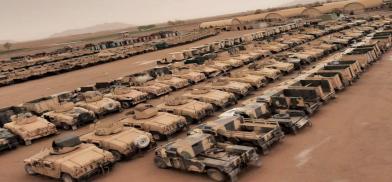War and environment: Cutting carbon footprints of militaries to save ailing climate
In Afghanistan, in addition to emitting millions of tons of carbon dioxide during the conflict, the US military footprint contributed more directly to the immediate destruction of the Afghan environment.

Conventional calculations of the cost of war seldom include a major casualty - the environment. The toll is huge and runs on. This can be seen now. The Russia-Ukraine conflict started last February and shows no sign of letting up. The Israel-Hamas war saw the first break in seven weeks of fighting after a ceasefire came into effect on November 24, but the bloody confrontation has resumed again. The two conflicts have seen a rapidly rising death toll, many injured and huge numbers of missiles, weapons and dollars in billions pouring in to stoke the fires. The harm this kind of conflict causes the environment is unimaginable and difficult to compute.
In addition, it comes at a time of an escalation in the climate crisis. As wildfires raged in Izmir, Turkey and July was on track to be the hottest recorded month, UN Secretary-General Antonio Guterres warned that the era of global warming had ended and that of “global boiling” had begun. A few months later in October the latest standoff in Gaza between Israel and the Hamas started. The cost of such wars is multifarious. In the conventional sense, it has been thousands of lives lost and billions of dollars spent. But what about the cost of such wars on the climate? The use of rockets and missiles, tanks or even the overall conducting of a war entails a massive consumption of resources and a highly detrimental impact,
Impacts are of two kinds - direct and indirect. For the first, there is a loss of vegetation, emissions from vehicular usage, or the use of gasoline-powered energy sources in war camps. The second does not lend itself to such exemplification. It is much more difficult to understand and quantify the latter, however, it is the one that needs to be watched as it continues well past the actual conflict. For instance, B2B bombers when deployed, apart from emitting greenhouse gasses (GHG) also leave behind persisting cirrus clouds contributing significantly to aircraft emissions forming part of climate emissions’ warnings.
Environmental havoc of US wars
As large-scale users of fuels and other energies, militaries account for 5.5 per cent of GHG emissions. That number may not immediately strike anyone as staggering, but for context, had the US Department of Defense been a country it would be the 55th largest emitter of GHGs. In other words, a singular department of one country, through its activities would be ahead of 140-odd countries of the world. A recent study from Brown University’s “Cost of War” project says it may not be surprising then that the world’s largest industrial-military complex is also the biggest polluter on Earth. In its “quest for security” America spends more on the military than any other country and much more than the military spending of its major rivals, Russia and China, says the study. With an armed force of more than two million people, 11 nuclear aircraft carriers and the most advanced military aircraft the US is capable of projecting power anywhere in the world. And it is. The US has been continuously at war since late 2001, with the US military and State Department currently engaged in more than 80 countries in counterterror operations. All this capacity and use of military force requires great energy most of which is sourced from fossil fuel. The Department of Defense (DOD)is the world’s largest institutional user of petroleum “and correspondingly, the single largest producer of greenhouse gases (GHG) in the world” finds the study. These GHG emissions are not just a result of war, but of ongoing non-war operations and maintenance of military operations.
Since the present period of American conflicts began with the invasion of Afghanistan in 2001, the US military is estimated to have emitted a staggering 1.2 billion tons of carbon into the atmosphere. In comparison, the entire annual carbon emissions of the United Kingdom are around 360 million tons. The massive additional burden is not justifiable as the biggest components of the US military’s carbon footprint have been in unnecessary wars and occupations that were not in any way connected with national security interests. In Afghanistan, in addition to emitting millions of tons of carbon dioxide during the conflict, the US military footprint contributed more directly to the immediate destruction of the Afghan environment.
The environmental havoc wreaked by the war in Iraq has been worse. It led to a spike in carbon dioxide emissions through military activity and poisoning of the environment by toxic munitions. The environment has become so toxic in some places that it has led to elevated rates of cancer and crippling birth defects. A British doctor who co-authored two studies on the environmental impact of US military operations in Fallujah said the city’s population suffers “the highest rate of genetic damage in any population ever studied.” Much of this is blamed on the use of depleted uranium munitions by US forces.
Despite promising to stop, a study by the independent monitoring group Airwars and Foreign Policy Magazine found that the military continued to use toxic munitions during the bombing campaign in Syria.
Sustained engagement as in the case of the current conflicts doesn’t help attempts to curb emissions. The Kyoto Protocol of 1997 and the Paris Agreement of 2015 had left out military emissions saying any limitation could impinge on national security. Thus, defence forces are not bound by international climate agreements to report or cut their carbon emissions from military vehicles, flying jets and sailing ships as they were left out of the 1997 Kyoto Protocol on reducing greenhouse gases - and exempted again from the 2015 Paris Accords. Both because data about energy use by armies could undermine national security.
Call for military emissions reporting
Now, environmental groups and academics from the British universities of Lancaster, Oxford and Queen Mary are pushing for more transparent military emissions reporting. There has been some work undertaken to examine this question. The UK Military is looking at emissions reductions by 2050 - setting the foundations, minimising, and fitting for the future.
In India, while it is the fifth largest spender on the military and ranked between 20 to 25 on the list of GHGs, climate change does not feature as a prominent concern. In the Joint Doctrine of the Indian Armed Forces 2017, it is acknowledged only from the security perspective, as a ‘non–non-traditional’ challenge.
How much a different approach can help with the military is left to be seen. A report titled Climate Collateral, published by the Amsterdam-based Transnational Institute says there is little scope for militaries to be ‘green’ for the following reasons - lack of fuel alternatives, new weapon systems are no less polluting, most GHG reduction strategies are vague and based on false assumptions. But ways must be explored to cut the carbon footprints of militaries and not add their emissions to the pain of an ailing climate. Otherwise, the ill effects of war will hinder efforts to save future generations from inheriting an uninhabitable planet.
(The writer is an independent researcher and author. Views are personal. By special arrangement with The Billion Press)
I needs to spend some time learning more or understanding more.
Thanks for magnificent info I was looking for this information for my mission.
usual info a person supply in your guests? Is going to be back regularly in order to investigate cross-check new posts
Look complex to far delivered agreeable from you! However, how could
we be in contact?
Its very well written; I love what youve got to say.
But maybe you could a little more in the way of content so people could connect with it better.
Youve got an awful lot of text for only having 1 or
two pictures. Maybe you could space it out better?














Post a Comment